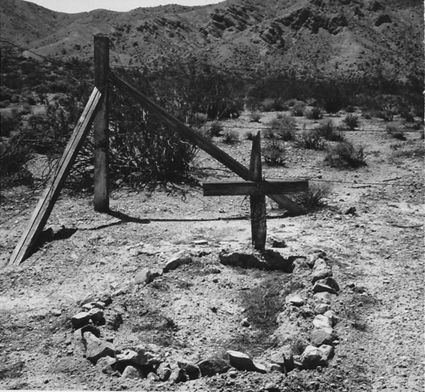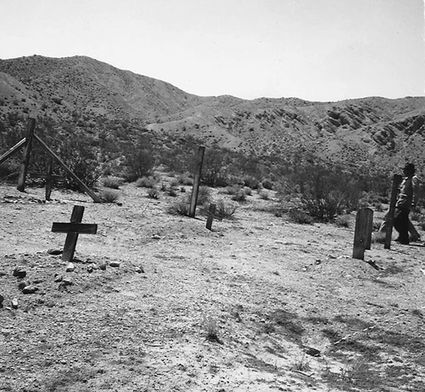Jawbone Canyon Cemetery Mystery
A Page of History
As usual, when going through my mother Marion Deaver's files, I find things that start another trail of research.
Such was the case when I found a photo of a grave with the notation "jawbone cemetery" on the back. This perplexed me, because I had never heard about any cemetery in Jawbone Canyon. I asked my son Clayton Strahan, who has been in Jawbone roaming around over the years if he had ever seen such a small cemetery, and he had not.
I searched online and came up with nothing. So, I turned to my source at the Tehachapi Museum, who has also become my friend, Del Troy, who helps maintain the library there. She also is a member of a county wide committee whose members are documenting cemeteries throughout the county.
Ms. Troy had never heard of the cemetery either. She planned to take the photo to the next committee meeting and see if anyone knew anything about it. I met her at the library and looked through some items there and did not find anything.
I left, but that darned photo was bugging Ms. Troy as well, and she continued to search and found an article that my mother had written in 1966 about cemeteries in the desert!
It was a "eureka" moment for both of us.
Turns out the cemetery was created for men who died while working on the "Los Angeles-Owens Valley Aqueduct." The little cemetery, in 1966, was surrounded by a wire fence which protected the graves. Some had weather worn markers, whose writing had long since faded away. Others simply were sunken spots in the ground.
I had the photo and I had identified why the cemetery was created but I wanted more. I went to the Los Angeles Water Associates Museum and read about the construction of the aqueduct. Hard rock tunnels were carved out, but perhaps the most challenging was the Jawbone Siphon portion of the aqueduct which almost went straight up the side of a mountain.
That portion was constructed by pipe on top of the ground and it is still there today, working great.
The engineers decided that new tractors, which the workers named "Caterpillars", because that's how they looked when they were driven, should be used. However, the tractors could not handle the rough terrain, and required much and expensive maintenance. They decided to go back to 52 mule teams to pull the pipe sections up the hill.
The 52 mules were needed to pull 30-ton sections of steel pipe up the hill, the usual 20 mules were not enough. The pipe sections were riveted together by other workers. It took over a year to accomplish the completion of the Jawbone Siphon.
What does this have to do with the cemetery? In this article I found out that "Whistling Dick", who was 78 at the time, came out of "retirement" and ran the mule teams, until his death – and guess where he was buried – in the Jawbone cemetery!
He was a mule skinner who drove the 52 mule team wagons and was both "mystery and legend" of the old west, according to the museum article. A postcard showing him with his mule team was loaned to the museum by Ed Fleming, of Mojave, Calif., to be copied in 1971.
The postcard showed Whistling Dick riding on the left wheel mule, guiding it. His swampers rode on top of the load of pipe.
Whistling Dick's full name was not listed anywhere, and I imagine if we could still make out his grave marker it would read: "Whistling Dick".






